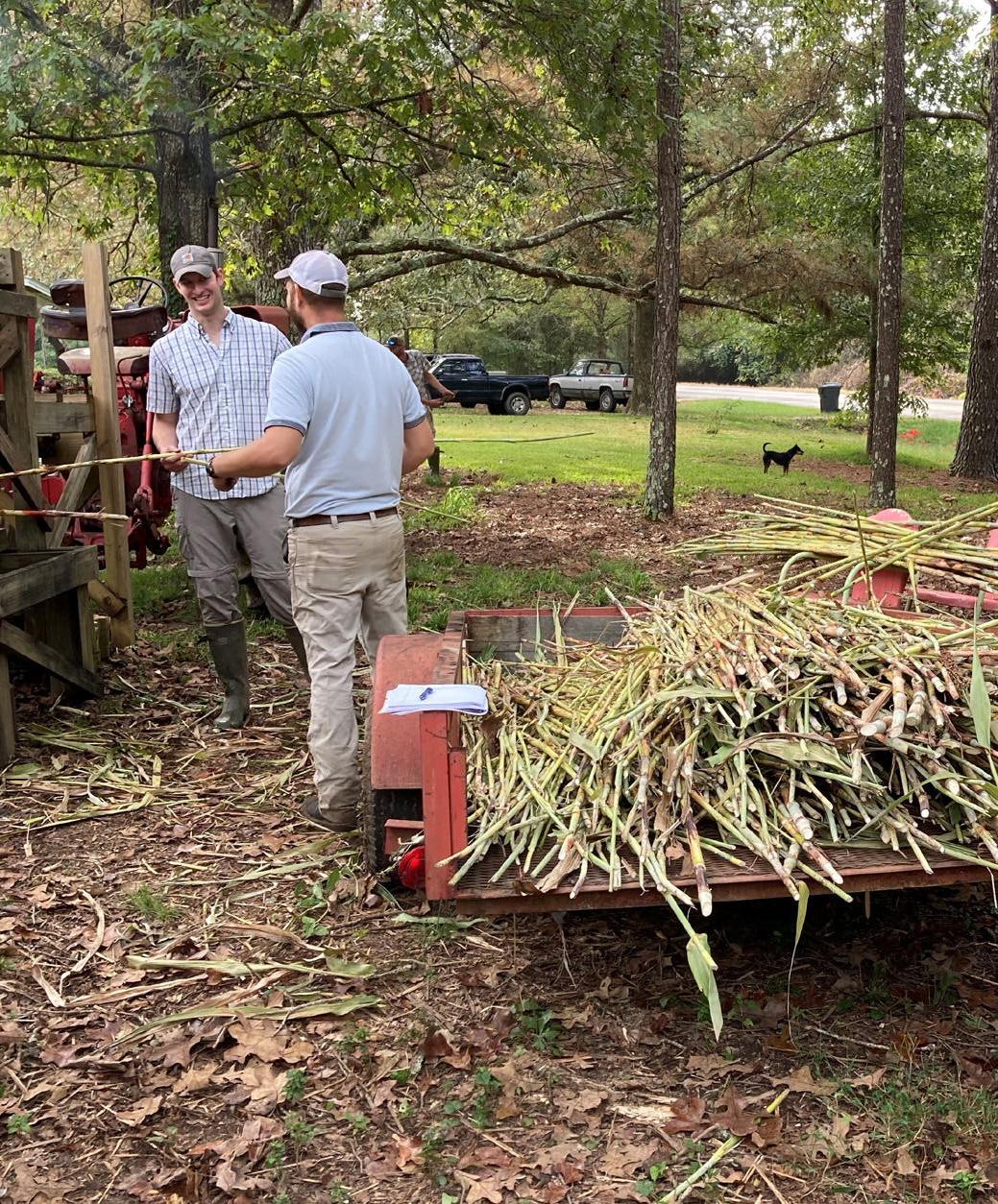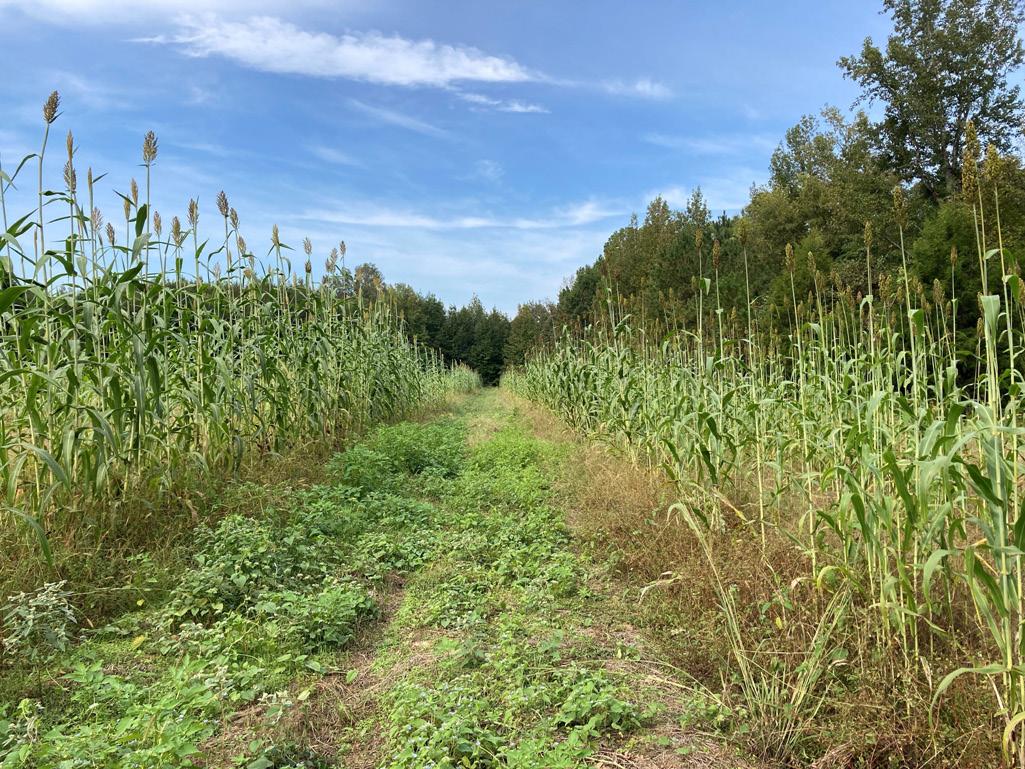
9 minute read
FRESH FROM THE FARM: Uncle Leo’s Sorghum
Uncle Leo’s Sorghum:
Sweetenin’ Up the South
Advertisement
BY JAY REED
In the world of sweeteners, words get thrown around a lot. Or perhaps I should be more polite and just say, when it comes to sweeteners, there is a lot of vocabulary to negotiate. Even when you eliminate the crystallized category—cane sugar, demerara, turbinado, powdered, dark and light brown—and focus on the pourable kinds, there are still a lot to keep up with. Some are brand names that are more or less their own version, like Blackburn’s or Lyle’s Golden. There are all kinds of varieties of honey.
Maple stands like a towering…tree…above all the rest, for sure, if you hail from a northeastern state or married into one of those families (raising my hand). I’m not sure how you define pancake syrup, but however that shakes out, a family of names emerges here, too, like Hungry Jack and Mrs. Butterworth, who host a big family reunion at the Log Cabin.
Then we get down to the basics. These are the syrups whose honor families defend at all costs because that’s what their

grandparents made, or maybe their parents—or as we will soon see, the current generation. These are the patriarch syrups. And this is where the syrup vocabulary debate gets sticky. Perhaps you’ve heard of ribbon cane, or pure cane, or sorghum, or molasses, or blackstrap or likely some combination of those terms. As best I can tell, trying to define syrup is akin to saying what kind of barbecue is best: you may be right, but somebody is still going to argue with you.
When our local farmer’s market re-opened early this summer, I met two vendors for the first time: Willow Farms and Bakery and Sky Blossom Flower Farm. As the names suggest, Willow brought produce and baked goods; Sky Blossom had flowers. I found Willow Farms first because… cookies. Lemon crinkle cookies got oohs and ahhs when I brought them home, the baguettes were perfect for our family’s favorite sandwiches, and the produce was beautiful. In the middle of that bounty were some jars full of dark syrup, with labels that read, “Uncle Leo’s Pure Sorghum Syrup.” I bought a jar.
Later, I noticed that Sky Blossom, which had amazing flower bouquets but no other food products, was also selling Uncle Leo’s. I made the observation out loud and soon learned that Jamey (from Willow Farms) and Skyler (from Sky Blossom) were both married to Willers brothers (David and Ethan): greatnephews of the actual Uncle Leo.
Products like this fascinate me, particularly when locally made, so I asked questions. Yes, I learned, they made it themselves right outside of town. And yes, I could come to watch them make it. (I guess I got right to the point!) Once I knew that the time for sorghum making would be in the fall, I stayed in touch, and in early October, I went to Maben for the first sorghum milling of the season.
Before I headed for the farm, I did a little pondering from my past. From what I had seen personally, sorghum took two very different paths. I lived in the Middle East for a few years and saw fields of sorghum that I first mistook for corn. Those crops were probably used for animal feed or made into flour for bread and other grain-based dishes.
However, my earliest memories were indeed of syrup, though it’s not something my family kept around very much. As my interest in food and trying new things grew, I began to acquire

syrups that weren’t Blackburn’s (my family’s go-to) or pure maple (the pantry staple of my wife’s family.) At the moment, in the same cabinet as Uncle Leo, I have a bottle of “unsulphured organic molasses” that claims to be made from organic sugar cane. On the back of the label, the ingredient list is short: “blackstrap molasses.” I also have a can of “sorghum molasses table syrup,” made semi-locally (in Mississippi), which lists these ingredients: corn syrup, sorghum syrup and citric acid to prevent crystallization. It’s not hard to see where the confusion comes from.
When it comes to the technical definitions, however, it’s pretty simple. Sorghum syrup comes from the sorghum plant. Sweet stalks are crushed to produce juice, that juice is boiled to evaporate the water, and syrup is the result. True molasses, however, begins with sugar cane. The juices of those crushed stalks are also concentrated by boiling, which results in crystallized sugar; molasses is a by-product of that process. The process can actually be repeated with the same batch another time or two, ultimately producing the darker, less sweet, blackstrap molasses.
I went out to the Willers farm early on an October Saturday to see the process for myself. The first thing that caught my attention was the trailer load of sorghum cane harvested by hand a day or two before—cut with a machete and stripped of its leaves using heavy gloves. The field where it was grown was just a short four-wheeler ride from the milling shed. Ethan took me out to see where this batch had been cut, and where the next was growing. Milling days are largely determined by when the sorghum plants have matured, and this stand was ready for harvest.
Meanwhile, David and another brother, Nathaniel, along with their father Jeff and a few of their kids, were back at the shed, pushing the cane through the 3-roller mill, built somewhere around 1903. As the story goes, the mill belonged to their great-uncle Leo, and David remembers going to help as a very young boy. Currently, the wheels of the mill are turned using parts from other machinery that have been cleverly set up so that a tractor does most of the hard labor. But they do keep the original part designed to connect to a pole with a donkey on the other end, that on milling day would make more laps than a NASCAR driver.
The mill’s primary parts are the heavy wheels that crush the stalks and extract the juice from the sorghum cane. The cane is fed into the wheels, and the juice runs down a spout into a bucket through a cheesecloth filter. The woody parts of the plant come out the other side and contribute to composting. Throughout the day, adjustments are made on the wheels to control the speed and ensure the juice is not lost.
Once the bucket is full, that juice is poured into a settling tank. The larger particles that make it through the filter settle to the bottom, allowing for a clearer juice. Once the settling period is over, the juice moves through a pipe to the boiling tank, which sits atop a wood-fired furnace.




The boiling tank looks like a maze, albeit a simple one, easy to solve. It is essentially a long, steel rectangle with baffles, sending the syrup slowly around corners until it reaches the end. By that time, assuming everything goes the way it should, the juice (initially about 15-20% sugar) has boiled down to a syrup (now about 75-80% sugar). The ideal temperature for pulling the syrup out of the tank is right around 228 degrees, but there’s not necessarily a thermometer handy that can accurately measure that kind of temperature. Over the eight or so years they’ve been doing this, the Willers brothers have learned that there is both art and science in the process.
Simply put for syrup nerd novices like me, the syrup boils at a certain temperature when it reaches the ideal percentage of sugar content, and that’s the optimal state they look for. However, the art comes from the tried-and-true methods of observation—is it the color they like? Is it dripping off a spoon too fast or too slow? And don’t forget the good old-fashioned tastebud test. But be careful: it’s hot at that end of the tank. Once it’s pulled, it passes through yet another filter into the final container, and when it gets cool enough, it goes into jars that Jo Anne Willers (the brothers’ mom) has prepared. On an average day, they get about a gallon of syrup from ten gallons of juice.
Since sorghum is a natural product, it does have a certain terroir. Batches made on different days or from different varieties of sorghum will vary in color, flavor and viscosity. All kinds of things can affect the process, and even if they can’t be controlled, they are monitored, such as outside temperature, humidity and barometric pressure. Even the furnace has to be built so that smoke from the fire won’t seep into the flavor of the final product.
The process is always a family project, sometimes a neighborhood event. Three generations of Willerses are involved, and this time, there was one food nerd there to document the goings-on, push a few stalks through the mill and join in the final product tasting.
I asked what they used the syrup for in their own kitchens, besides Jamey’s sorghum cookies that Jeff was passing around. Baking is obvious, and with the right guidance with ratios, it can be substituted for at least a portion of the sugar content in many recipes. But the jar label itself says, “Not just for biscuits!”
Lots of “outside the cookie” ideas were bounced around by the other family members, including adding to soups, glazing meats, drizzling on sweet potatoes or topping pancakes (though I was warned, it may not soak in like other syrups.) One brother said that he enjoys a little pour in his red beans and rice. I like it as a mild sweetener in my overnight oats or plain Greek yogurt, but most of what’s in my jar—thanks to a sorghum latte I had once at a biscuit joint in Alabama—goes into my morning coffee.
Sorghum syrup—Uncle Leo’s, especially—is truly a product of the land. The cane is grown, cut, crushed, boiled and bottled on the same small farm. The earth provides an incredibly versatile plant, which (depending on the variety) can provide forage, flour or sweet fluid. And families like the Willerses, thanks to the legacy of Uncle Leo and a 100-year-old piece of machinery, transform that cane to give us the gift of syrup.
To learn more or keep up with Uncle Leo’s Sorghum, visit their Facebook page at www.facebook.com/UncleLeosSorghum. edm









